You may not find this terribly rewarding unless you're included here, so this is a good time for casual and random browsers to turn back before they get too caught up in the sweep and majesty of the proceedings and can't let go.
We're not based in Europe anymore, and we've struggled through the covid-19 lockdowns like everyone else, so we haven't set foot in Italy since February 2019. Now we're making up for lost time with mad sightseeing, but missing the cats even more sorely as the days fly by.
Ten days in Ascoli Piceno (and thereabouts)
We've got a hired car at the Fiumicino airport near Rome -- they 'upgraded' us to a Mitsubish SUV battle-tank that's remarkably unsuitable for medieval Italian villages, but at the moment we've been cruising along the A24 autostrada, 150 miles (240km) NNE over the Apennine mountains, and for ten miles under the Gran Sasso National Park, to Ascoli Piceno (16 November 2022).
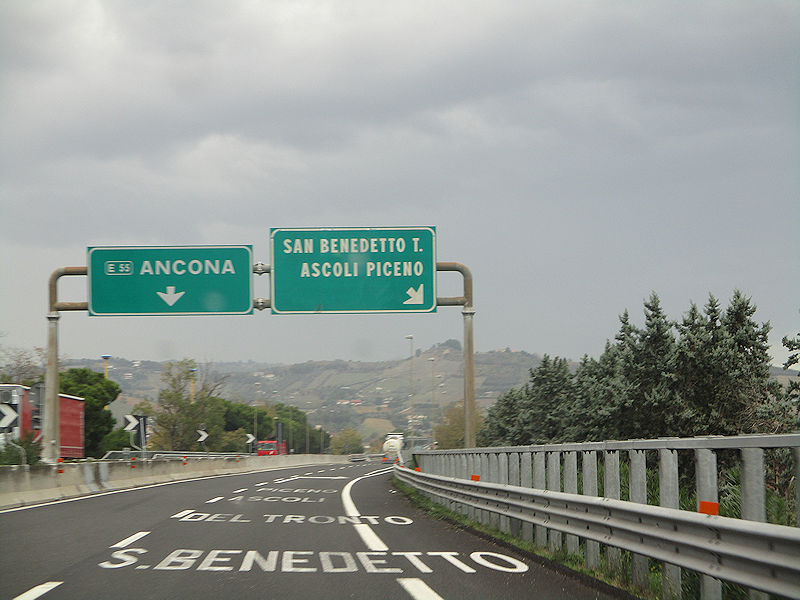
The A24 takes us down to the Adriatic coast, then after a 14 mile jaunt up the E55 coast highway towards Ancona to Porto d'Ascoli, we turn back up 17 miles towards the mountains on the 'Raccordo' to Ascoli Piceno.
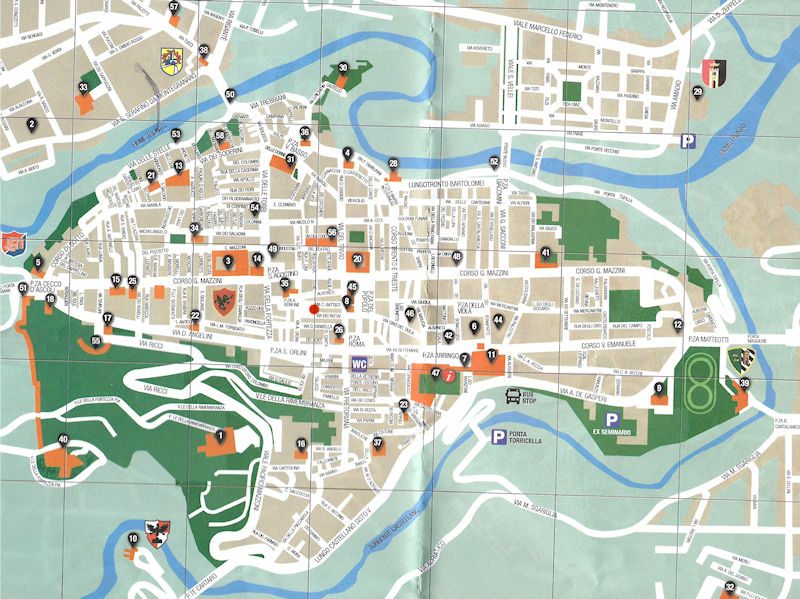
Ascoli Piceno is planted on the confluence of the Tronto River north of the old town and the smaller Torrente Castellano -- the large green area in the southwest is a sizable hill with city walls running up it and a small fortress on top, so between the rivers on three sides and the hill on the fourth, the city was strategically very well placed. The old town seen here, the Centro Storico, is in the Marche region, almost straddling the frontier with the Abruzzo region just to the south. (Newer parts of town extend along the river another four miles down to the right. The population of the whole ensemble in 2022 is said to have about 46,000 souls; it is now and probably always has been the capital of the Ascoli province.)
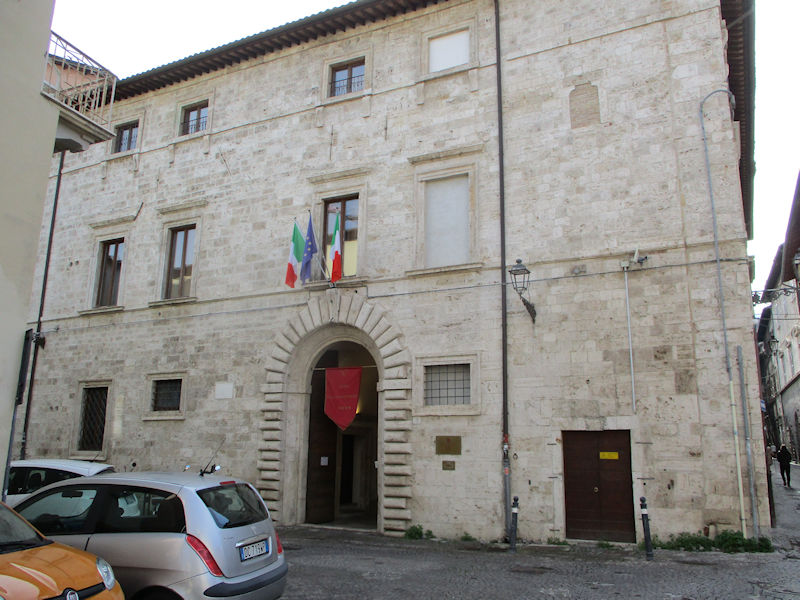
Our accommodations, in the lovely old Palazzo Guiderocchi, are centrally located on the Via Cesare Battisti, 3, the red dot in the city map just above. We got the Mitsubishi tank in here to unload and had the valet service drive it back out to a carpark outside of the city, where it remained until we were ready to leave a week hence.

The palazzo dates from the 15th/16th century, owned by the then-powerful Guiderocchi family. According to texts on the hotel's website, in the 15th century Tommaso, 'of a warlike nature', became the charismatic leader of the city, conquered many neighboring lands, and allied the city with Venice, Naples, and the Papacy; in 1482, however, he renounced the Papacy's claim to overlordship. He died in 1488, leaving as heirs a daughter Flavia and son Astolfo.
Flavia is said to have been known as the 'Warrior Maiden' for her predilection for archery, swordplay, and wearing armor, having in 1459 'fought like a lion' in a successful attack on nearby Castello di Controguerra. But in 1498 a popular uprising led by pro-papal Guelphs against 'the tyrant' Astolfo set fire to the palace and forced the family into exile. 'Fierce struggles followed between armed gangs, between internal and external troublemakers who deteriorated the free civic institutions', and the citizens chose to put themselves back under papal oversight. In 1515 Astolfo was able to return and rejoin the city council 'under the guidance of the Papal State'.

There are 23 rooms in the Palazzo, and we're starting out in the Flavia Suite on the 2nd floor (the 3rd floor by the US count). We'll be moving to another room in a few days to accommodate some repairs of a water leak somewhere.
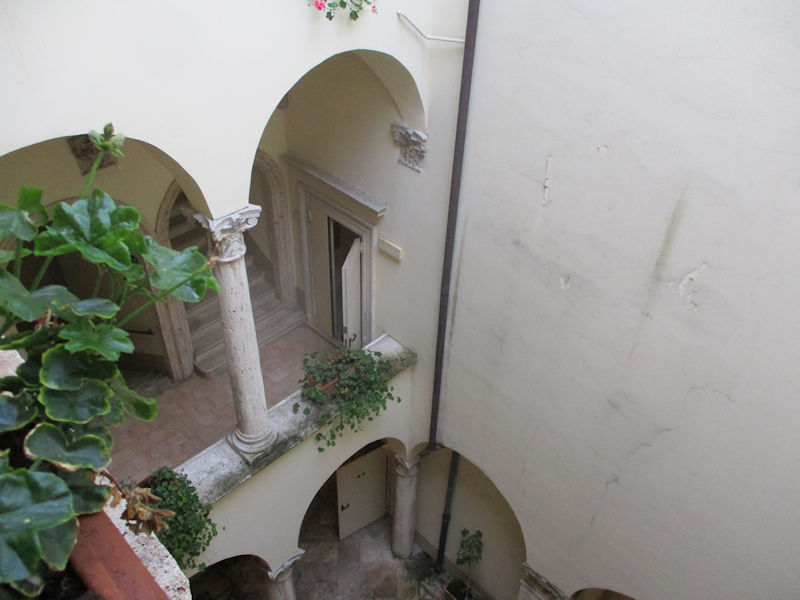
There is an elevator, but it's only necessary for baggage-lugging.

There are several vintage salons like this one leading off to the individual rooms and suites.

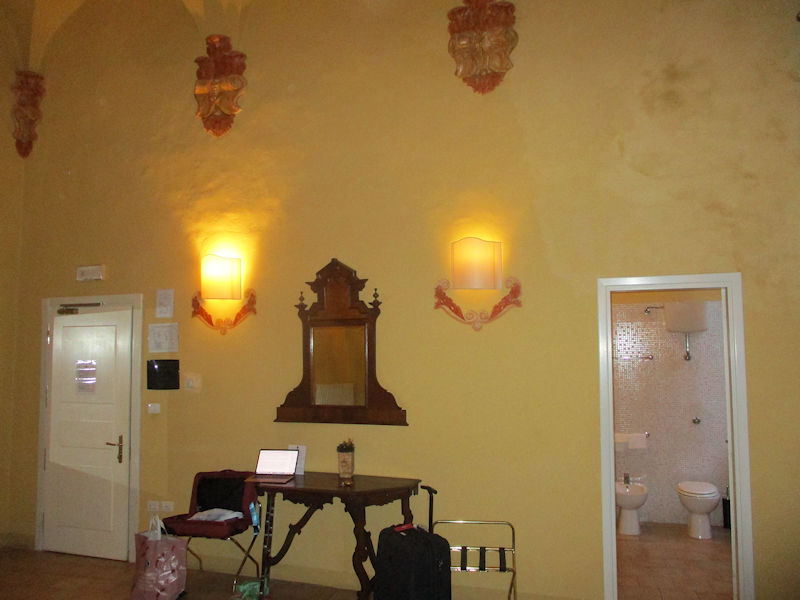
Here's the enormous Flavia Suite.
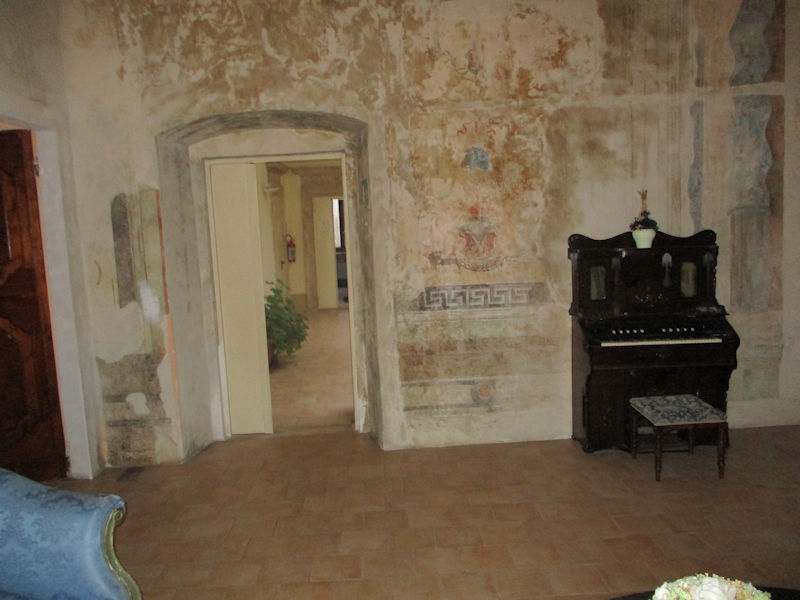
The adjacent public salon

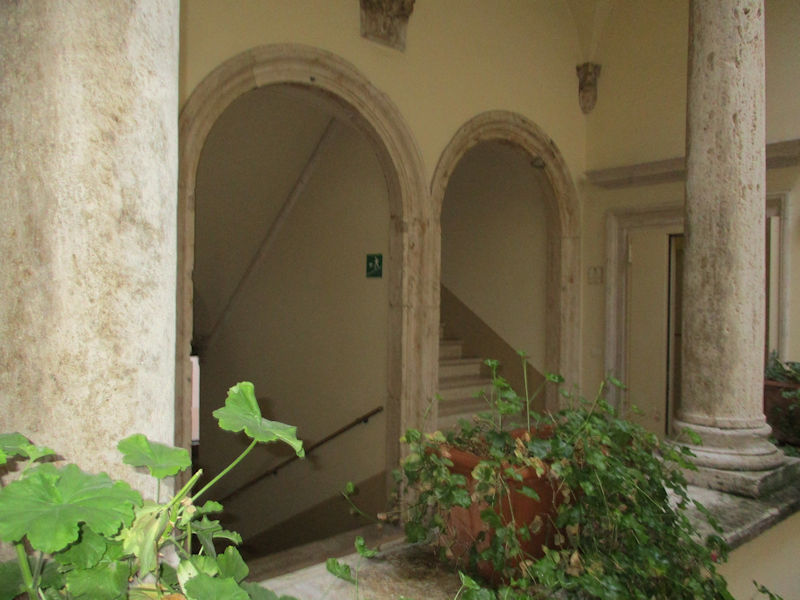
It's nearly time for dinner.

Awaiting stragglers
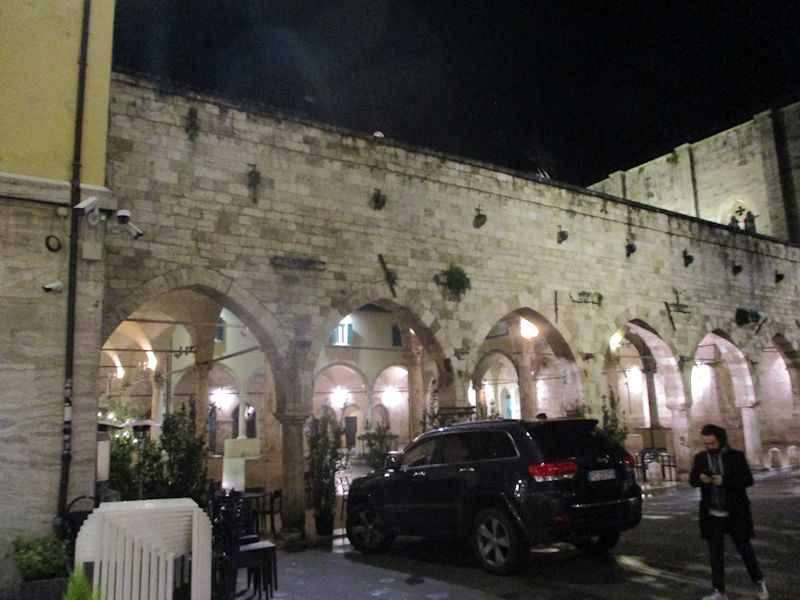
A block and a half over, this is the cloister attached to the Chiesa di San Francesco, lit up like a lively public gathering place, which it is. It was built between 1565 and 1623 and has been adapted for use as a marketplace.

We're investigating round the cloister square, and . . .
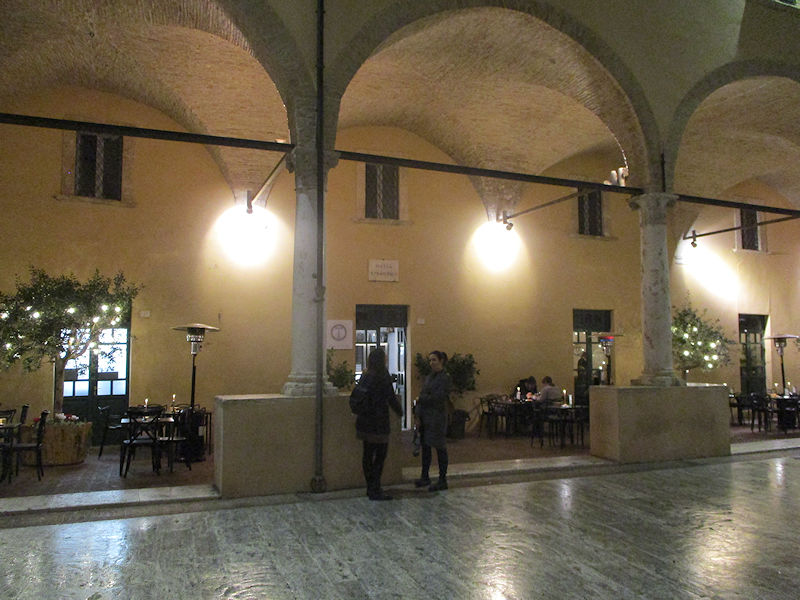
. . . there's our restaurant, the Osterie e Botteghe Francescane in the Chiostro Maggiore di San Francesco -- we went there as often as possible until several days later they closed for the season.
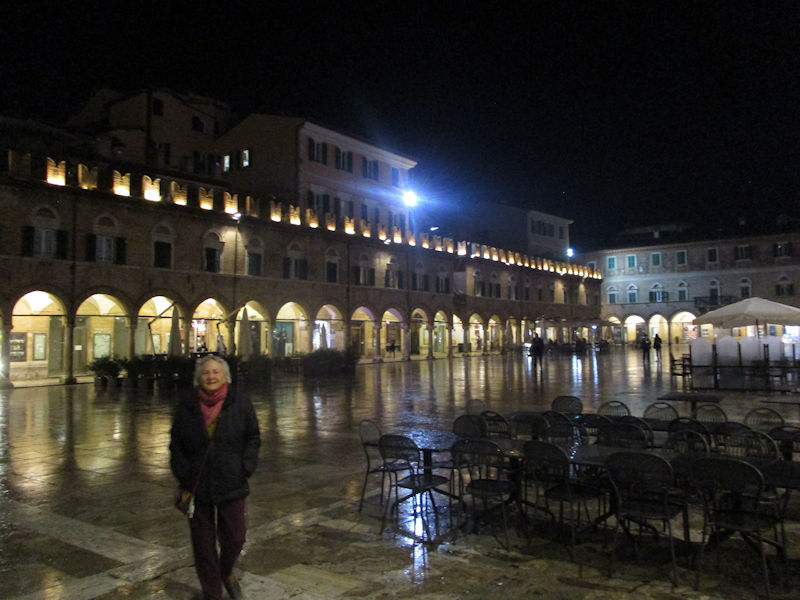
A brief drizzly evening walk round the Piazza del Popolo next door -- that's for tomorrow.
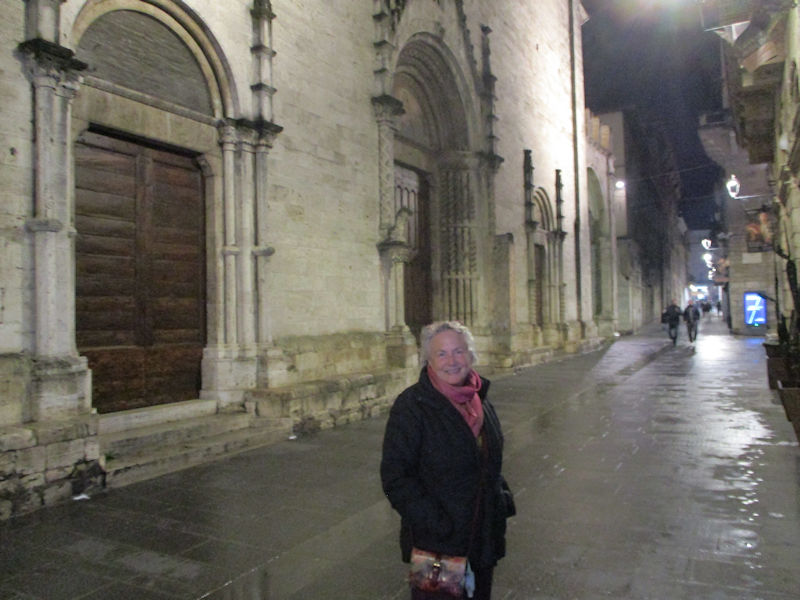
Back past the Church of St Francis on the Via del Trivio near the head of our street, Via Cesare Battisti, which is named for the Italian patriot executed in Trento by the Austrians in 1918.
Cities that grew up under Roman administration were normally laid out on a rectangular grid in a similar way: from one city gate, an east-west major road, called the Decumanus Maximus, bisected the town to a city gate at the far end, and it was crossed by a somewhat smaller road
called the Cardo Maximus running north-south to its own city gates. In Ascoli, the Via del Trivio is the Cardo.
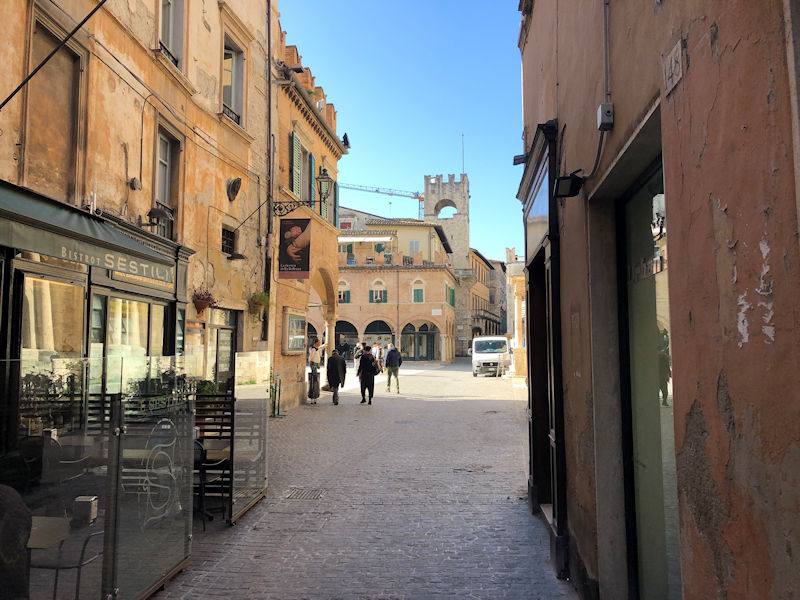
The next day, we're back to have another look at the Piazza del Popolo, the People's Square, 17 November 2022.
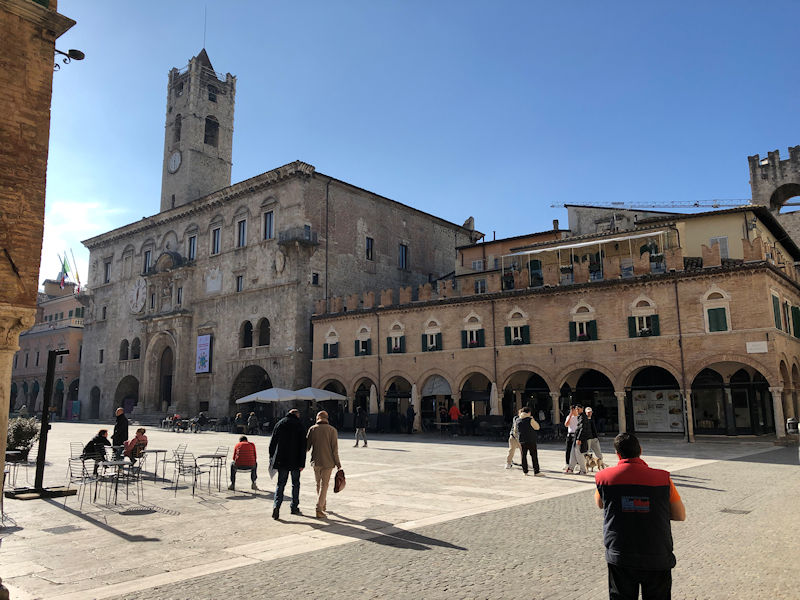
Here, at the northern end of the Piazza del Popolo, we're standing on the Corso Giuseppe Mazzini, which is the city's east-west Decumanus Maximus. The huge building in the centre of the square is the Palazzo dei Capitani del Popolo, a medieval label for a 13th century building formed out of three pre-existing ones that evolved from the People's Captain's residence to the Podesta's, then to the city Elders', and then to the Papal Governors'. The belltower was originally a patrician family's defensive tower.
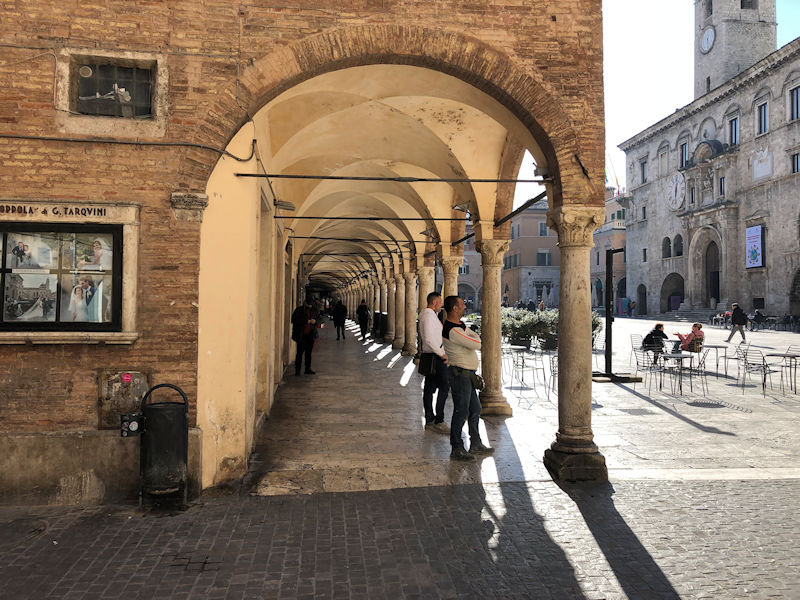
The Picenes or Picentes began to become distinct from other Italic peoples in the early Iron Age, and from the 9th century BC they were predominant in the coastal regions along the middle Adriatic, the present-day Marche and Abruzzo regions. They attracted Roman attention by their presence along the Via Salaria, the Consular Salt Road trade route between the eastern salt works and Roman Latium, and in spite of unsuccessful resistance in 269 BC, in 268 the Piceni centered on Asculum (the Roman name for the chief centre) were given the status of civitas foederata, a free and independently governed entity 'allied' to Rome.
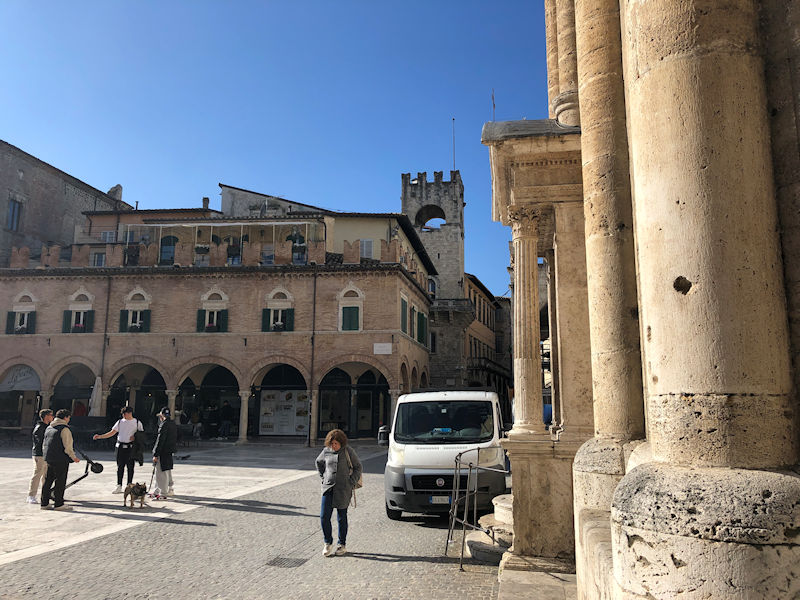
On the right is the side door of the St Francis Church, looking along the Corso Mazzini.
In 91 BC, Ascoli joined other independent Roman allied cities (the 'socii') in the rebellion called the 'Social War', calling for full Roman citizenship for the allies. When the Ascolani murdered the Roman supervisor and residents of town, the Consul Pompeius Strabo (a native of Picenum and father of Pompey the Great) marched an army to the scene and laid Ascoli under a devastating two-year siege; after the huge Battle of Ausculum in 89 BC in which Strabo defeated a substantial Italian army coming to relieve Ascoli, the people of the city surrendered, and Strabo (called 'the vilest man alive') marched in, burnt all of the buildings, and murdered the majority of the population.
The Romans, however, at the end of the Social War in 87 BC, granted the opportunity for Roman citizenship to rebel communities and individuals who requested it.
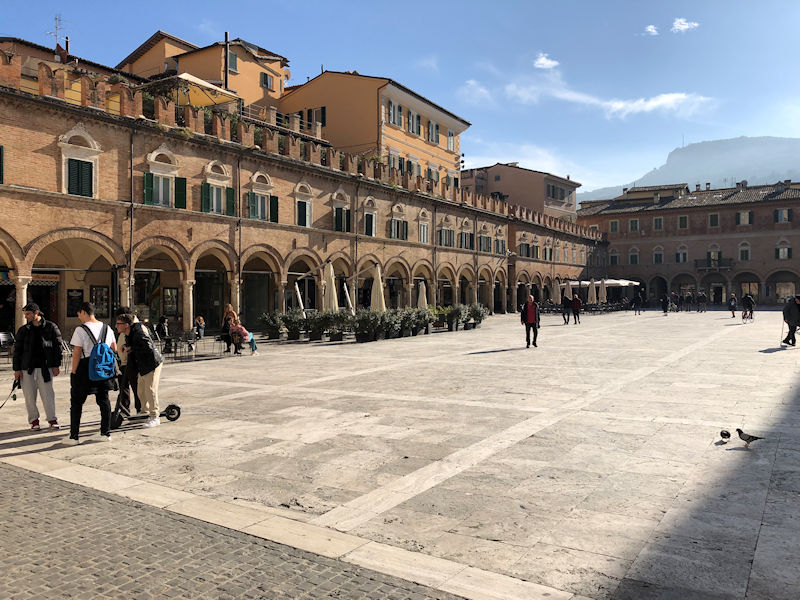
The long porches on both sides of the broad marketplace of the piazza date from the 16th century.
In the 6th century AD, Ascoli suffered during the Gothic Wars (535-554), and in 568 the Germanic Lombards (aka the Longobards) took advantage of the devastations of those wars and migrated into northern Italy, creating a northern Kingdom of Italy, with Pavia as its capital in 572. They arrived in Ascoli in 578. In 774 Charlemagne closed the Lombard kingdom down, but there were two independent Lombard duchies in the south, Spoleto and Benevento, and Ascoli was ruled as part of the Lombard Duchy of Spoleto from 593 to 789, following which, as in many Italian cities, the local bishops took over the governance, normally as vicars of either the papacy or the emperor.
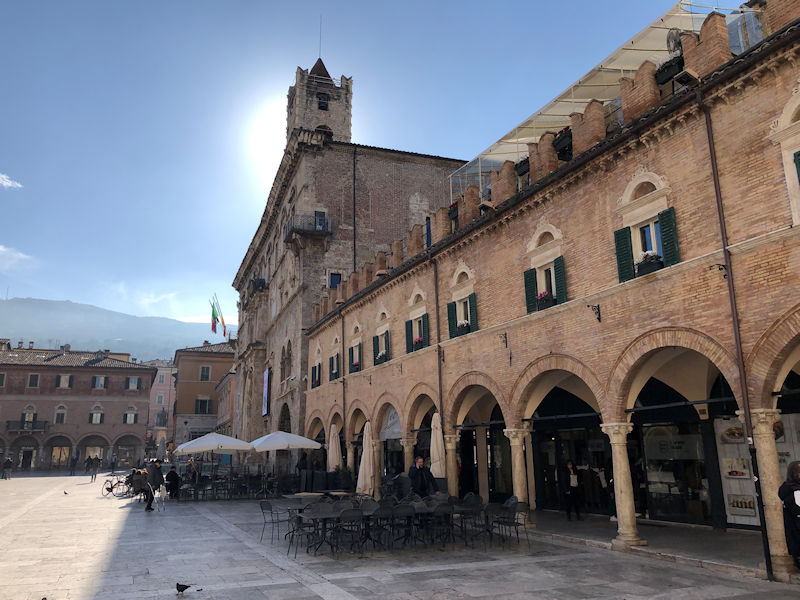
In 1189, in the general era of the communes, the citizens established a free republic municipality but, again as elsewhere, entered a protracted period of internal rivalries and a decline of civic values, leading to clan feuds, the proliferation of fortified towers, and internecine violence, as well as predatory bullying of neighboring communities.
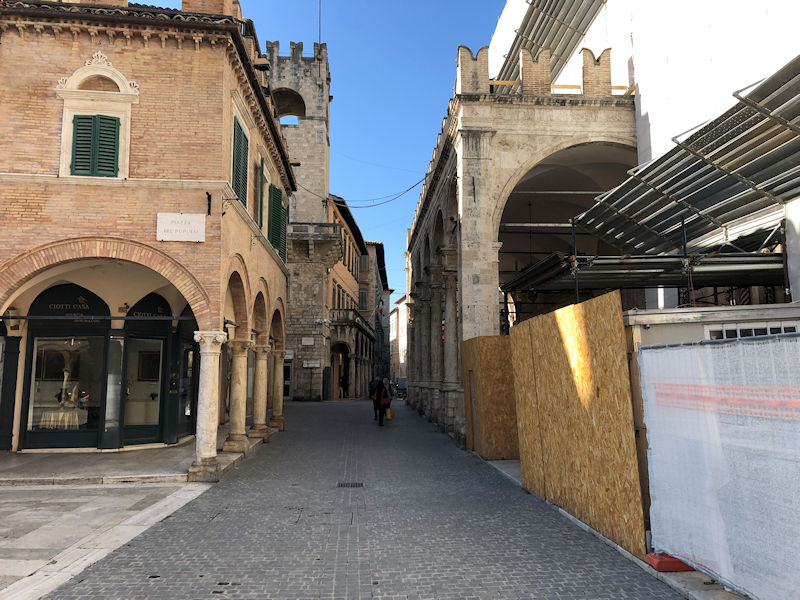
Onward, along the Corso Mazzini -- the structure on the right, a loggia with five arches built onto the side of the San Francesco church, is the Loggia dei Mercanti, financed by the Wool Corporation in 1513.
The chaotic political situation made the city prey to foreign strongmen; e.g., in the 1340s the citizens hired the mercenary commander Galeotto Malatesta of Rimini to lead them in a war against nearby Fermo, and he decided to stay on as a horrible tyrant, building the Fortress Malatesta at the east end of the city, until he was exiled from the city and enjoyed an active career as a paid warrior for everyone for the next 40 years. In the late 15th century, the city came more firmly under the control of the Papal State, until it was inducted into the new Kingdom of Italy in 1860.
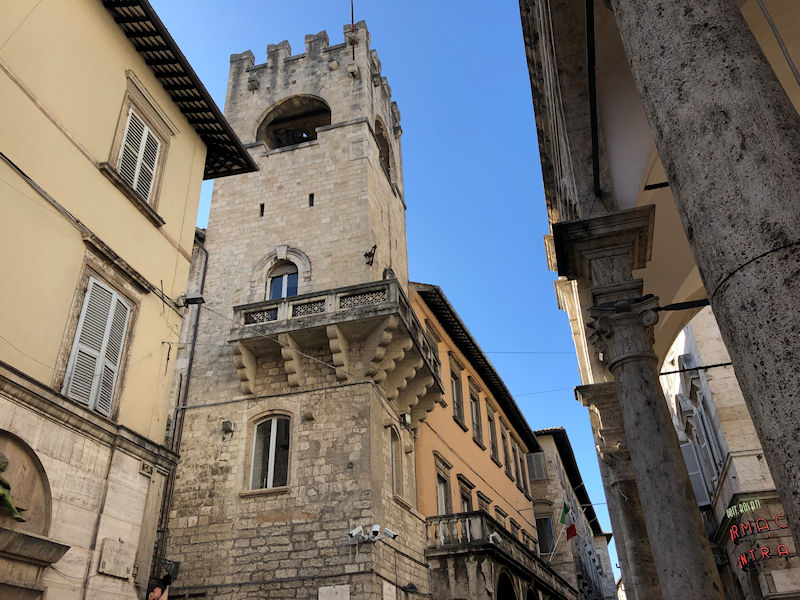
At its internecine peak during the commune era, unsettled social relations had led to the building of the nobility's defensive towers in many Italian city-states -- in fact, in Ascoli as many as 200 fortified towers. In 1242 the Holy Roman Emperor Frederick II Hohenstaufen (aka 'Stupor Mundi'), who was based in southern Italy and working to reclaim city-states for the Empire up the eastern coast and northern plains of the Po, ordered the destruction of over 90 of the towers here.
It's said that the remains of about 50 of the others can still be traced out here, sometimes intact though perhaps lowered, others having been converted to belltowers or with their bases incorporated into residential buildings.

The Corso Mazzini, one block west of the Piazza del Popolo, here crosses the Via del Trivio.

That's the Chiesa di San Venanzio in the Piazza Antonio Bonfine, facing the front door of the Palazzo Guiderocchi -- we never got inside that one. Oh well.

The Via Cesare Battisti, with on the left the Vinattiere osteria, another restaurant that we quite liked; it's adjacent to the Weedy Shop, 'Ascoli centro cannabis', and facing the back of the Palazzo dei Capitani del Popolo at the end of the street.
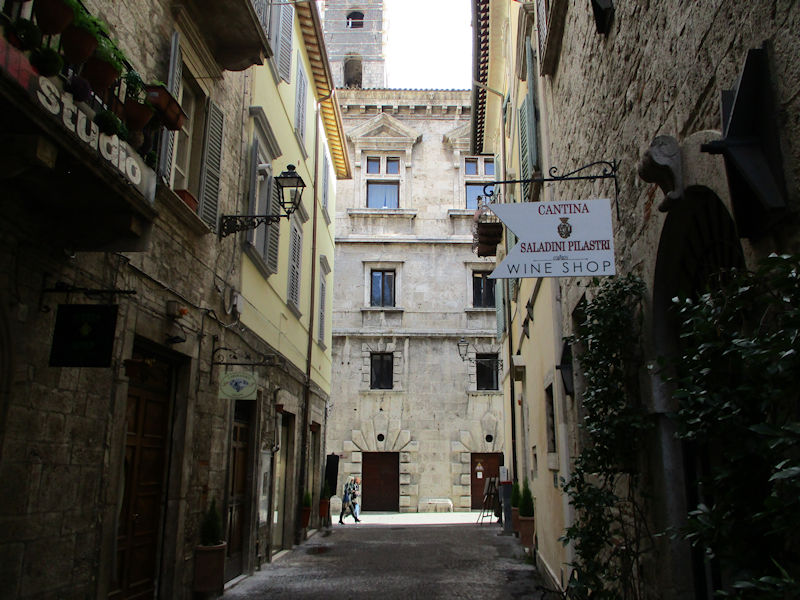
Still on Via Cesare Battisti, but soon to turn up . . .
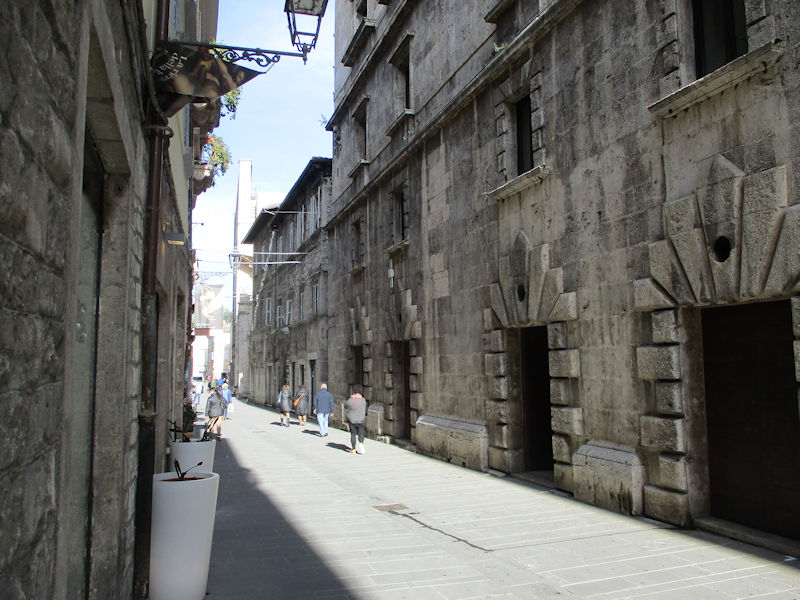
. . . the Via del Trivio towards the Piazza Roma.

The Piazza Roma at the head of the Via del Trivio. The statue is a war memorial, 'to our fallen sons'.


The Via Dino Angelini from the Piazza Roma, one of the very few two-way streets, and this one runs parallel to the Corso Mazzini and out the Porta Romana, the western gate of the old city.

The Libreria Rinascita bookstore
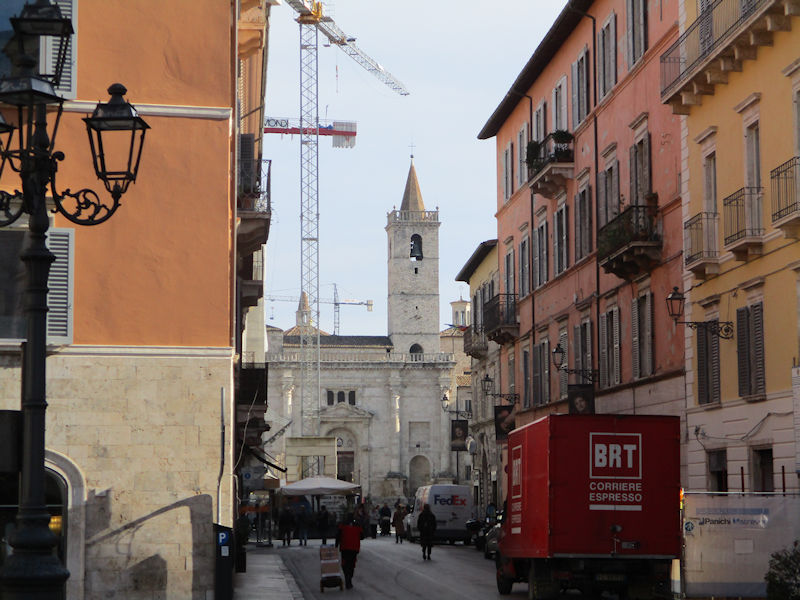
And farther along, a peek at the duomo
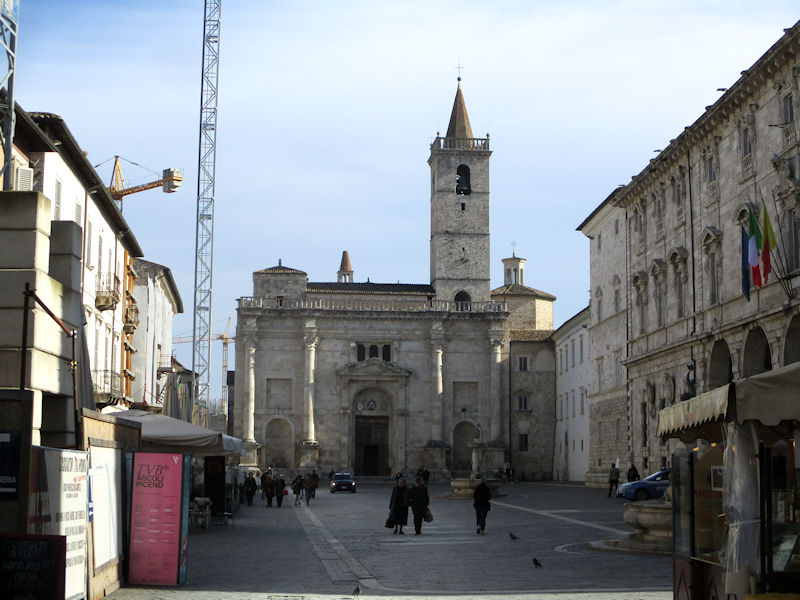
There it is, the Cattedrale di Sant'Emidio at the far end of the Piazza Arringo

The Piazza Arringo -- the name seems to come from the fact that it has always been the centre of political life in the city, including lots of hyper-passionate orations, and may be related to our word 'harangue' -- has grown up over what had been the Roman forum. The buildings on the right, the Palazzo Comunale, are a 17th-18th century reworking of two buildings, including the Palazzo Arengo, and behind the portico at the far end, the Palazzo Vescovile or Episcopal Palace.

The two matching fountains, with horses, fish, and angels, date from 1884.

A look back past the fish and angels to the Migliori shop, which helped us out significantly when our normal wine shop was closed, and it also specializes in the Ascoli specialité, the Ascolan Stuffed Olive.

The Arengo Palace, the Palazzo Comunale, also houses the city's art gallery, the Pinacoteca Civica, which we'll visit later.

Now for the Duomo (and the other angel and seahorses fountain)
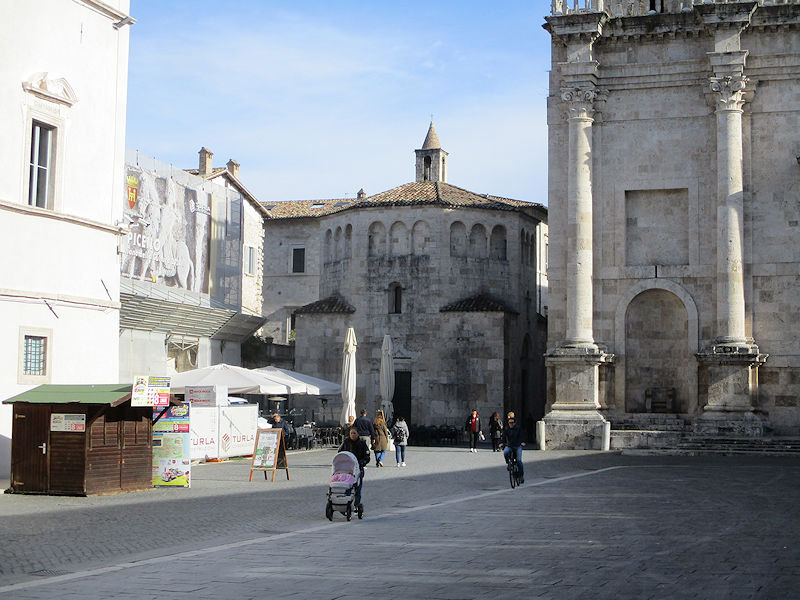
That's the Romanesque baptistry, reconstructed in the 12th century from another from the early Middle Ages. It's normally closed up, but we'll get inside it later this week.
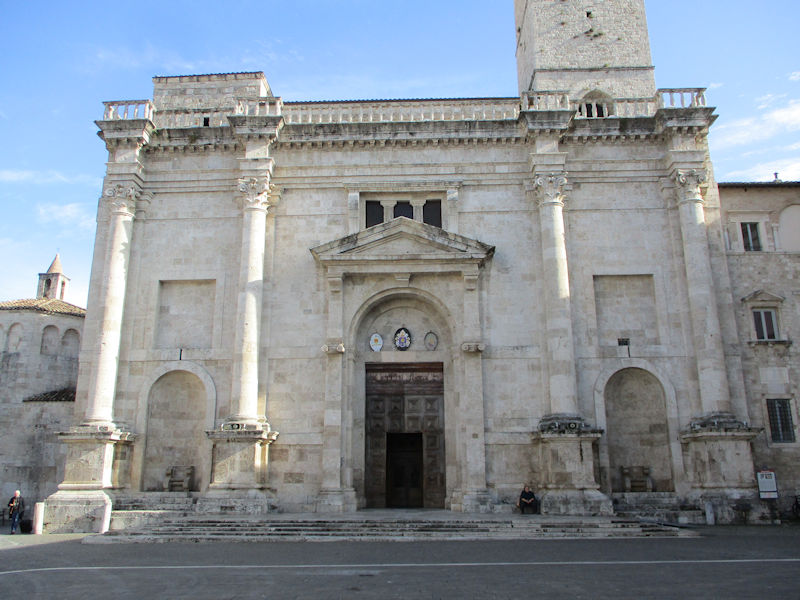
The Cathedral of St Emidio was built on the foundations of a Roman public building; it was used by early Christians, then reconstructed in the early 7th century. The big transformations, with side aisles and a new apse, among other things, took place following the papal Libertas Ecclesiastica of 1482 by Pope Sixtus IV della Rovere, granting the rights of self-government to the city, though the 16th century façade is unfinished.
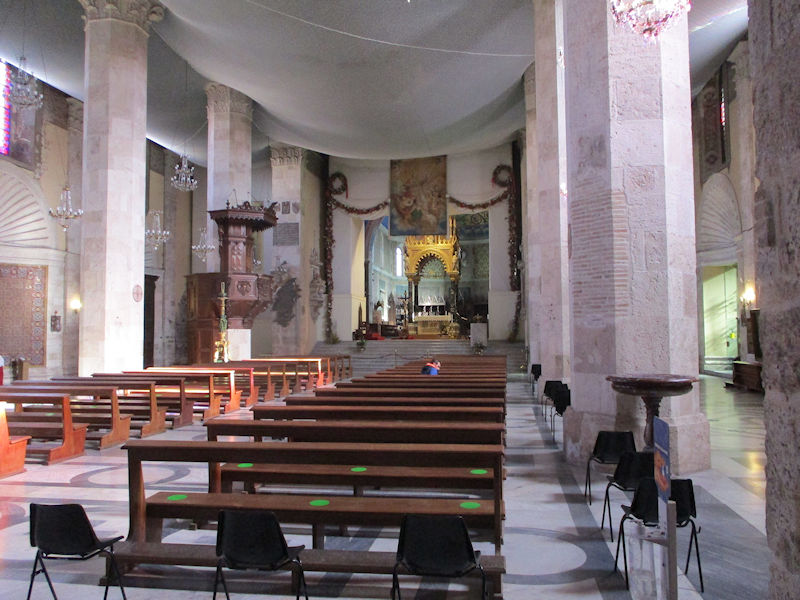
The cathedral is dedicated St Emygdius, Sant'Emidio in Italian, who came from Trier in Germany to Rome in the late 3rd century and did a lot of healing miracles, then was sent to be bishop of Ascoli. He made so many conversions to Christianity on the way and in the city, including of the local governor's daughter Polisia, that the governor had him decapitated in AD 303 (or so). Surprisingly, he picked up his head and carried it to an oratory he'd made in the mountains to give it, and himself, a Christian burial.
He was a popular martyr roundabouts, but especially so after a horrible earthquake in the region in 1703 left Ascoli Piceno unaffected, when a lot of towns appointed Emidio as their patron, as he is here. He was also notable for dissuading the Huns from attacking in 409, stopping a plague epidemic in 1038, and protecting the city from the Germans in October 1943.

The impressive altar canopy, or ciborium, in the apse, is modern, created in the International Gothic Revival style in 1895 by Giuseppe Sacconi (who also designed the Altare della Patria, the Vittorio Emanuele II monument on the Capitoline Hill in Rome).

The choir behind the altar
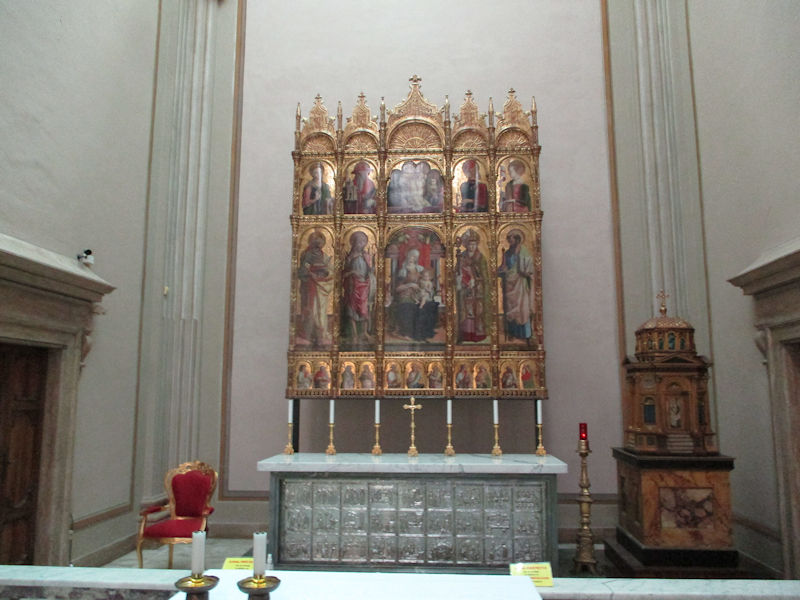
That's a polyptych altarpiece in the Chapel of the Holy Eucharist, bearing the date 1473, by the Venetian painter Carlo Crivelli (ca. 1435-1495), who after a jail term for adultery, ended up here in Ascoli, though few of his works remain here in his city.
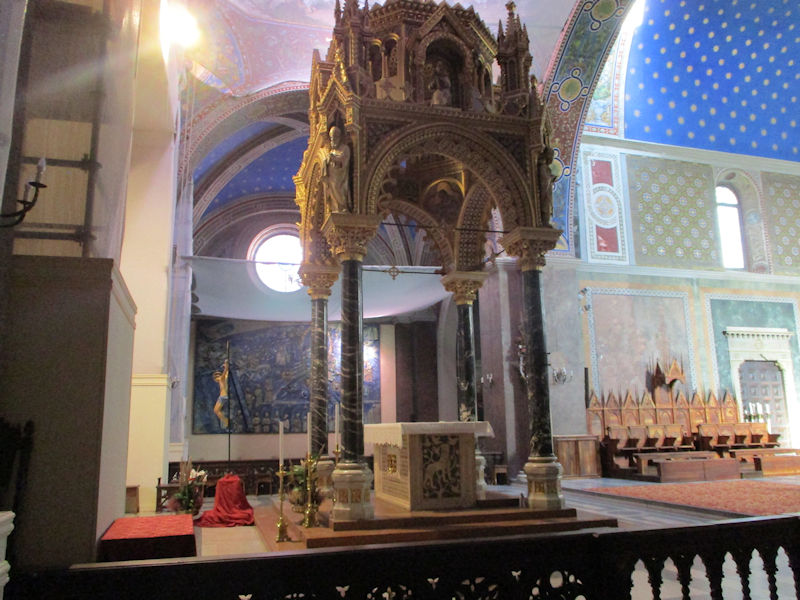
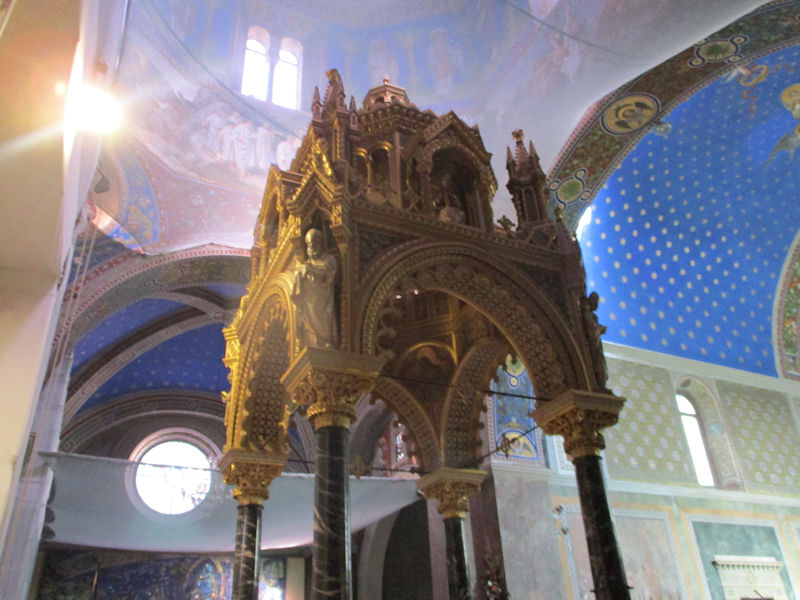
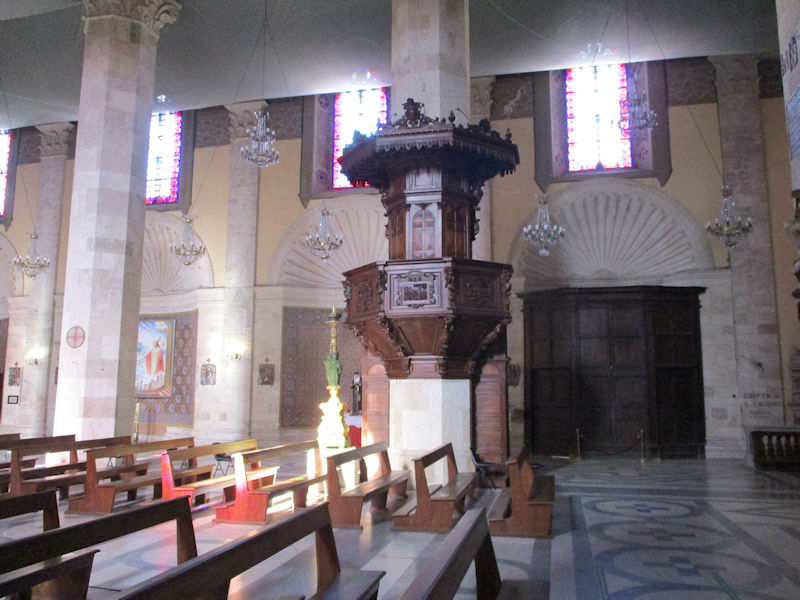
The pulpit, or ambo
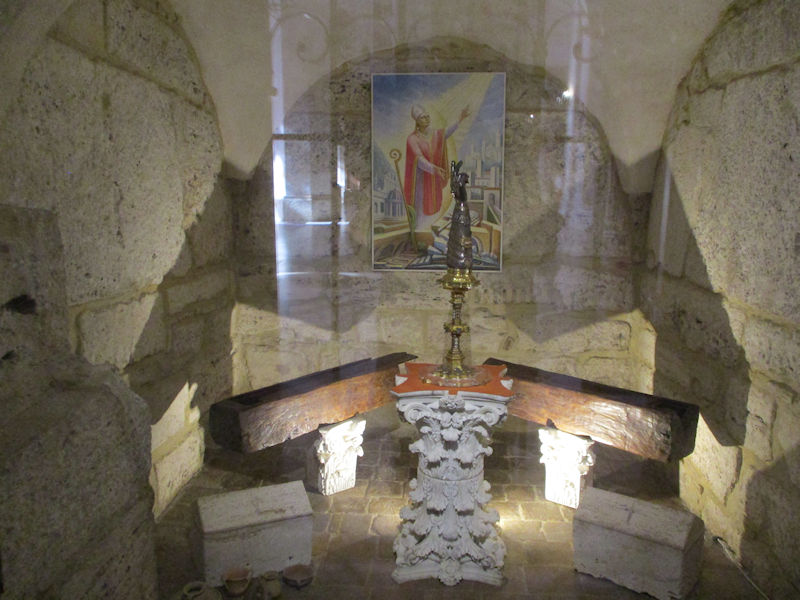
'We can also admire, in a niche to the right of the exit, the precious reliquary arm of Sant'Emidio made in 1482 by the Ascoli goldsmith Pietro Vannini. In gilded silver with precious stones, the work is the object of great devotion by the population' (source).
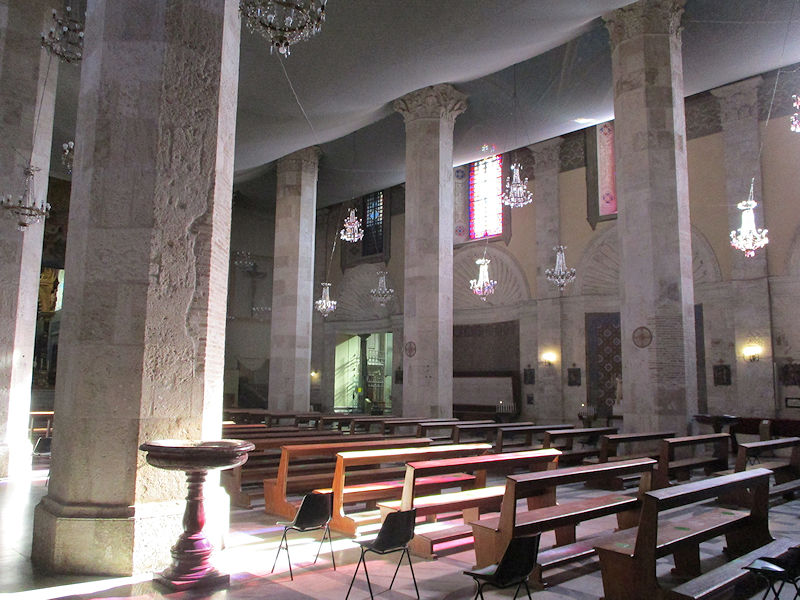
[What's with that ceiling?]
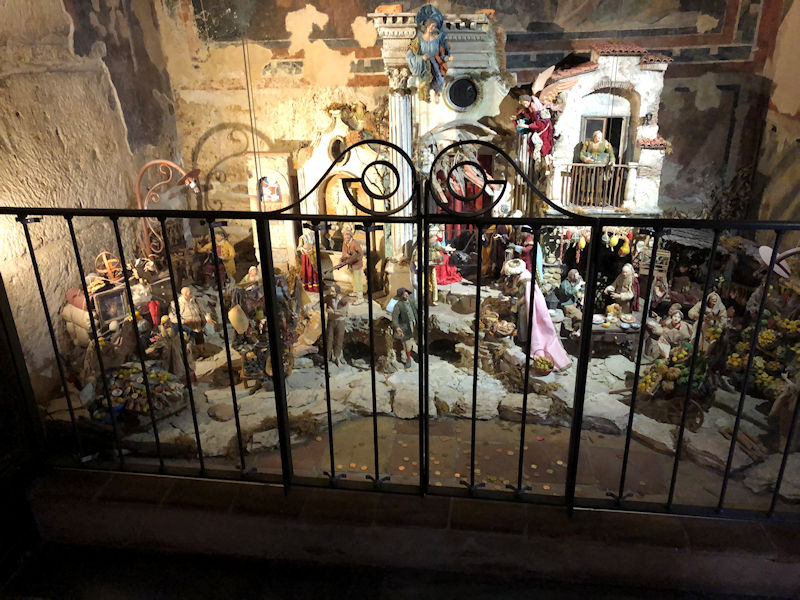
A crèche inside the front doors

The 12th century octagonal Romanesque baptistry round the side

The Palazzo Bazzani on the Corso Mazzini, built in 1912, renovated by and now the home of the Fondazione Cassa di Risparmio (or savings bank) of Ascoli Piceno. The bank was founded in 1842 but in recent years it's gone through a sizable number of mergers and acquisitions by holding companies from all over the map, and the Foundation here nowadays operates as a charitable organization.

Up there may be where, in the old days, the bankers could congregate to survey all their properties in the city, or reassure their clients when required.
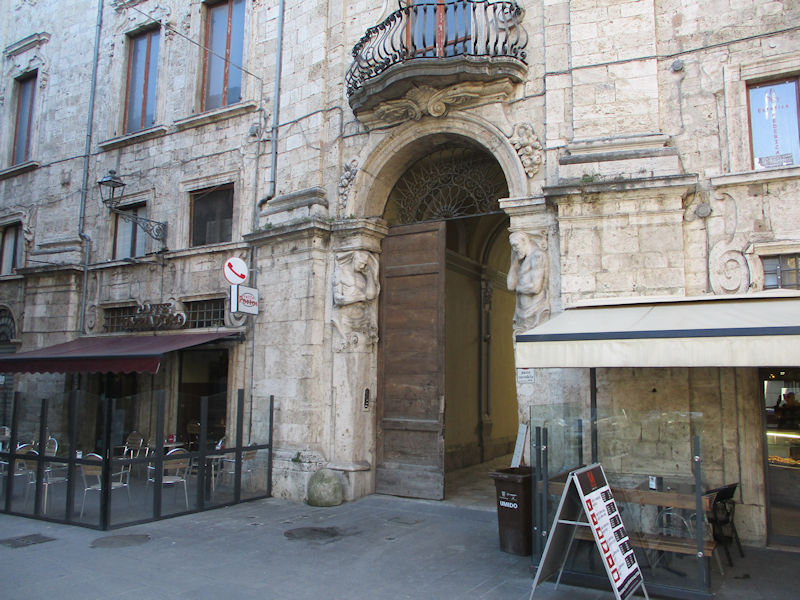
Across the Corso from the Bazzani Palace, a fine doorway between two cafe/bars
Arriving back towards the Piazza del Popolo. We'll be back.
 Dwight Peck's personal website
Dwight Peck's personal website















































































